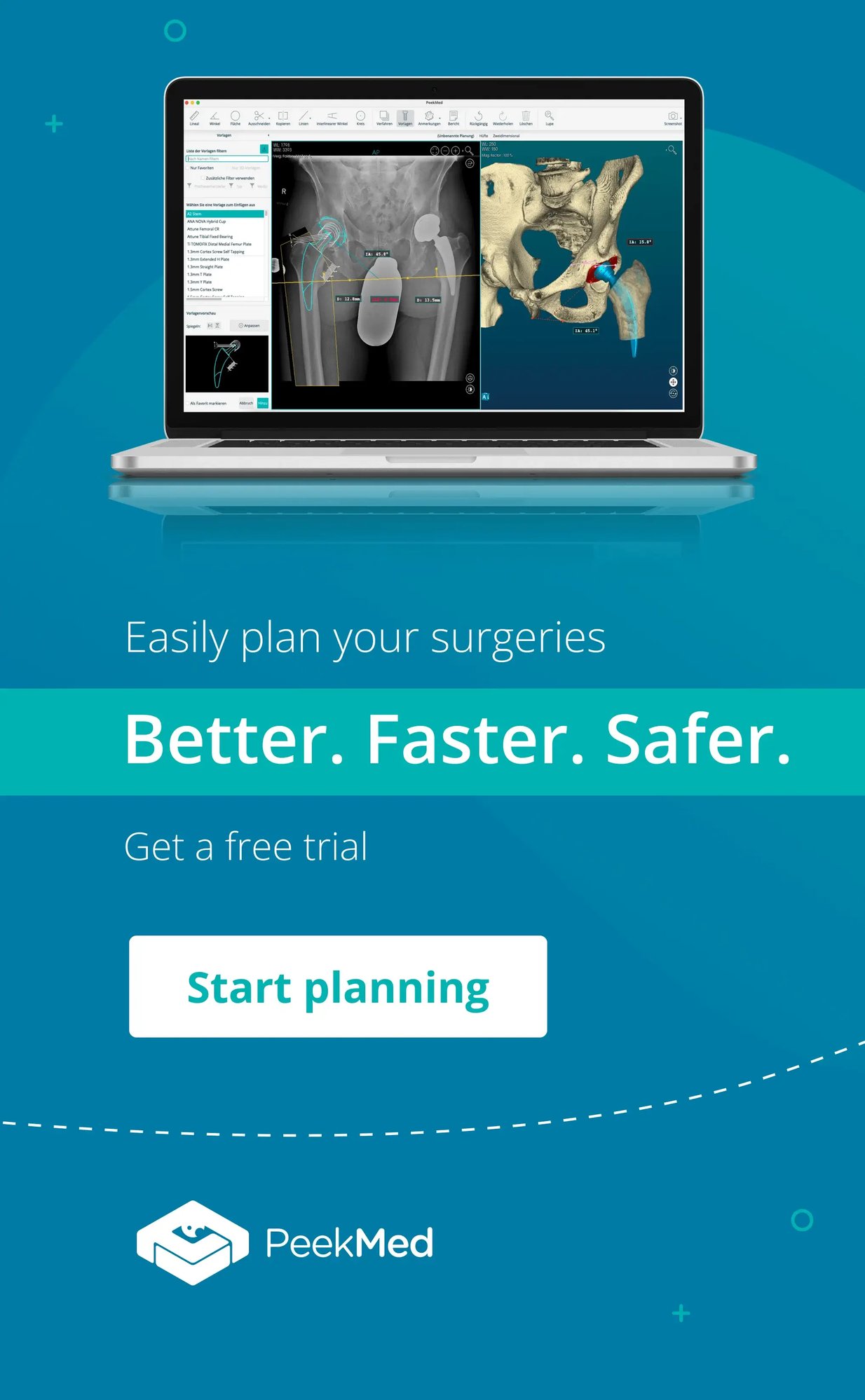PeekMed
Let’s be honest: walking shouldn’t be a struggle.
When a child’s knees knock together or their feet point inward (a condition known as in-toeing), many parents worry. And when adults continue to feel hip pain or gait issues from childhood, the concern deepens.
Here’s the deal:
If conservative care isn't enough, femoral anteversion surgery can dramatically improve quality of life, restoring comfort, mobility, and confidence.
In this guide, you’ll discover:
- What femoral anteversion is (and isn’t)
- When surgery is recommended
- What the procedure looks like
- How technology like PeekMed is changing the game for orthopedic surgeons
Ready to explore the new standard in bone alignment surgery? Let’s begin.
First, What Is Femoral Anteversion?
Femoral anteversion refers to the inward twist of the femur (thigh bone), which causes the knees and feet to turn inward. This twist increases the angle of femoral version beyond the normal range.
It’s common in children, and most of the time, it resolves naturally by age 8 to 10.
But what if it doesn’t?
That’s when adults start experiencing hip instability, joint pain, or difficulty walking. In adults, persistent femoral anteversion often leads to:
- Abnormal gait patterns
- Hip pain
- Knee discomfort
- Low confidence in movement
In such cases, it may be time to consider a femoral derotation osteotomy, a surgical treatment for femoral anteversion.
When Is Femoral Anteversion Surgery Needed?
Surgery isn’t the first choice. But in specific cases, it becomes essential.
Orthopedic surgeons typically consider femoral anteversion correction surgery when:
- In-toeing interferes with daily life or athletics
- There’s persistent pain or instability in the hips
- Clinical imaging confirms an excessive femoral rotation
- Non-surgical interventions (e.g., physical therapy, chiropractic care) have failed
The recommended approach? A femoral derotation osteotomy, a precise form of corrective femur surgery to realign the bone and restore proper biomechanics.
The exciting part? Modern technology makes this surgery far more accurate than ever before.
Inside the OR: What Happens During Femoral Anteversion Surgery
The goal of the surgery is simple: rotate the femur into proper alignment.
Here’s how it works:
The orthopedic surgeon cuts the femur, rotates it to the correct angle, and secures it with metal plates or rods. While that may sound invasive, modern preoperative planning and intraoperative tools have dramatically reduced risks and improved outcomes. This procedure realigns the femur with the hip and knee, optimizing both posture and mobility.
In the past, surgeons relied on 2D imaging and manual estimates.
Today, with AI-powered surgical tools, surgeons can:
- Simulate the osteotomy in 3D
- Customize the degree of correction
- Choose optimal hardware placement
- Prevent critical errors like wrong-site surgery
That’s not just planning. That’s preparation with precision.
Imagine this:
You're in the OR, facing a complex case of bilateral femoral anteversion. Instead of relying solely on manual measurements and anatomical “feel,” you have AI-powered software that visualizes the optimal rotation before you even make the first cut.
That’s the power of PeekMed’s surgical planning platform. It enables you to simulate different correction angles in 3D, tailor procedures to each patient, and avoid costly errors.
What Are the Risks and Recovery Time?
Like any bone alignment surgery, femoral anteversion correction carries some risks:
- Infection
- Nonunion or delayed bone healing
- Over- or under-correction
- Neurovascular injury (rare with modern planning tools)
Recovery typically takes 6–12 weeks, with most patients initially using crutches, then progressing to full weight-bearing. Physical therapy helps rebuild strength and gait mechanics.
And let’s be clear: the key to a smooth recovery is a well-executed preoperative planning phase and a personalized surgical approach.
Personalized Surgery: The Future of Femoral Corrections
No two femurs are the same.
That’s why personalized, computer-assisted surgery has become the gold standard.
As explored in our articles on computer-assisted surgery and personalized surgery in orthopedics, surgeons today rely on digital tools to guide every step, from diagnosis to drilling.
PeekMed provides a cutting-edge platform for:
- 3D modeling of the femur
- Case-by-case customization
- Seamless integration into your orthopedic workflow
This level of planning isn’t just high-tech, it’s high-impact.
You want precision. Your patients want relief.
Femoral anteversion correction no longer has to be a guessing game.
With tools like PeekMed’s preoperative planning software, you can deliver truly personalized, AI-supported orthopedic care and achieve better surgical outcomes with less risk.
Explore more of our insights on the future of orthopedic surgery.
And if you're looking to enhance your surgical planning with smarter tools, PeekMed is ready when you are. Because in the operating room, confidence starts with clarity.
References
- Hospital for Special Surgery (HSS). Femoral Anteversion.
https://www.hss.edu/health-library/conditions-and-treatments/list/hip-femoral-anteversion - Domb, B.G., MD. Femoral Anteversion vs. Retroversion: Their Differences and Treatment Options.
https://www.benjamindombmd.com/blog/femoral-anteversion-vs-retroversion-their-differences-and-treatment-options/?bp=31453 - Accident Care Chiropractic. Chiropractic Care for Femoral Anteversion.
https://accidentcarechiropractic.com/chiropractic-care-for-femoral-anteversion/ - Reikerås, O., Bjerkreim, I., & Kolbenstvedt, A. (2009). Anteversion of the Acetabulum and Femoral Neck in Patients with Osteoarthritis of the Hip. AJR American Journal of Roentgenology.
https://ajronline.org/doi/10.2214/AJR.09.3702 - Wheeless' Textbook of Orthopaedics. Adult Acetabular and Femoral Anteversion.
https://www.wheelessonline.com/joints/adult-acetabular-and-femoral-anteversion/ - News Medical Life Sciences. Treatment Options for Femoral Anteversion.
https://www.news-medical.net/health/Treatment-Options-for-Femoral-Anteversion.aspx - Lurie Children’s Hospital. Femoral Anteversion in Children.
https://www.luriechildrens.org/globalassets/media/pages/specialties--conditions/conditions/femoral-anteversion/femoral-anteversion-eng.pdf



